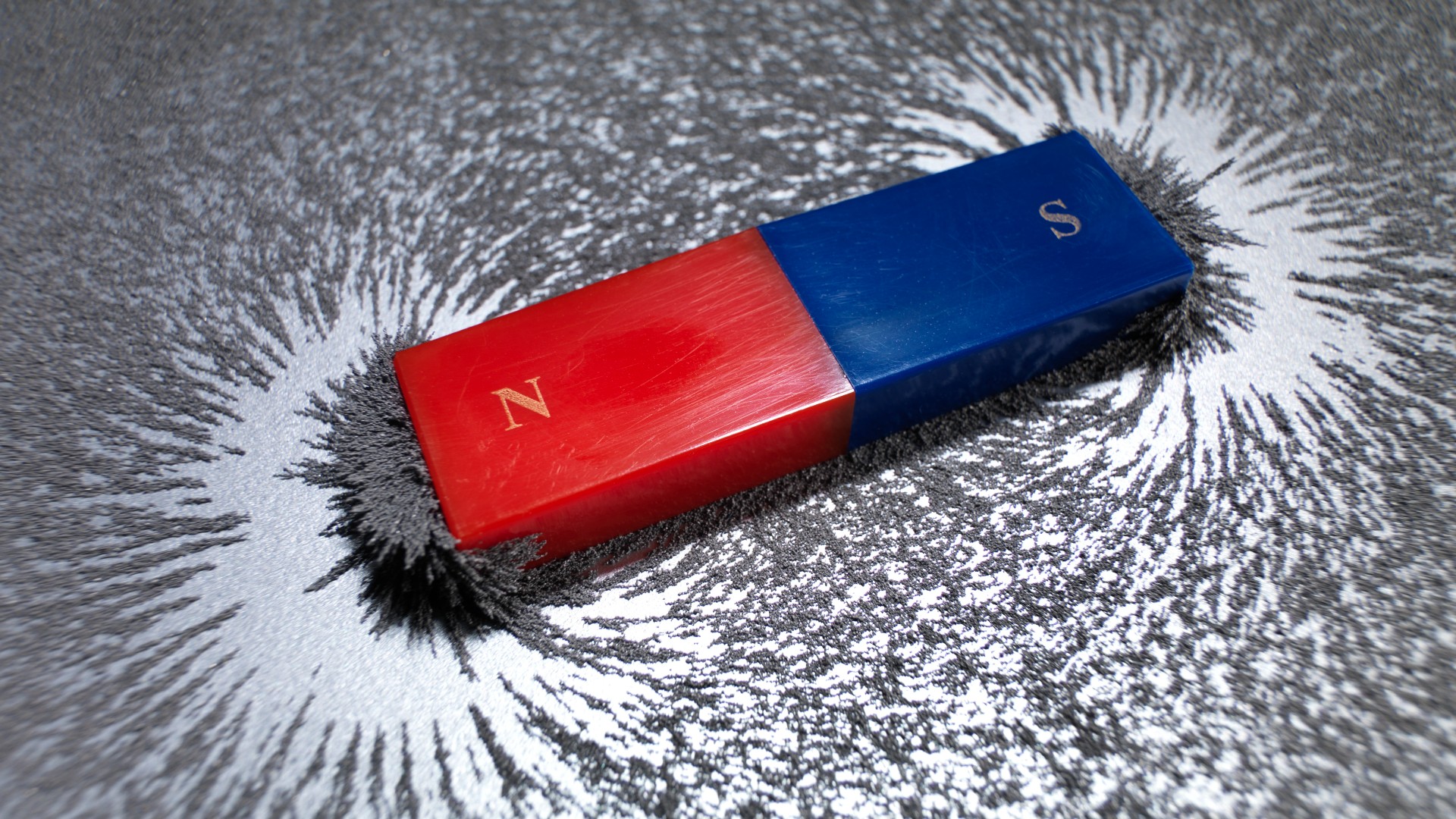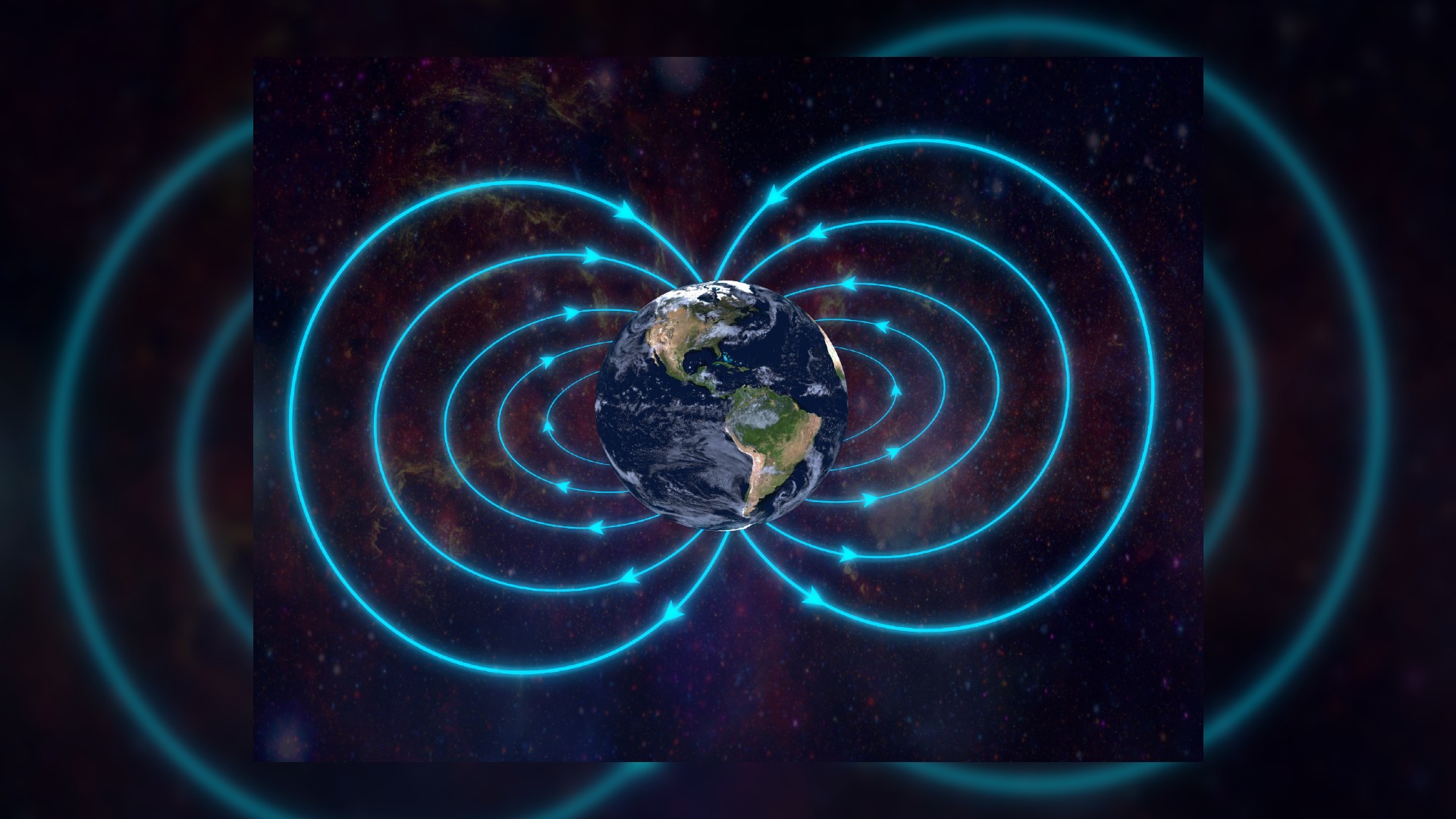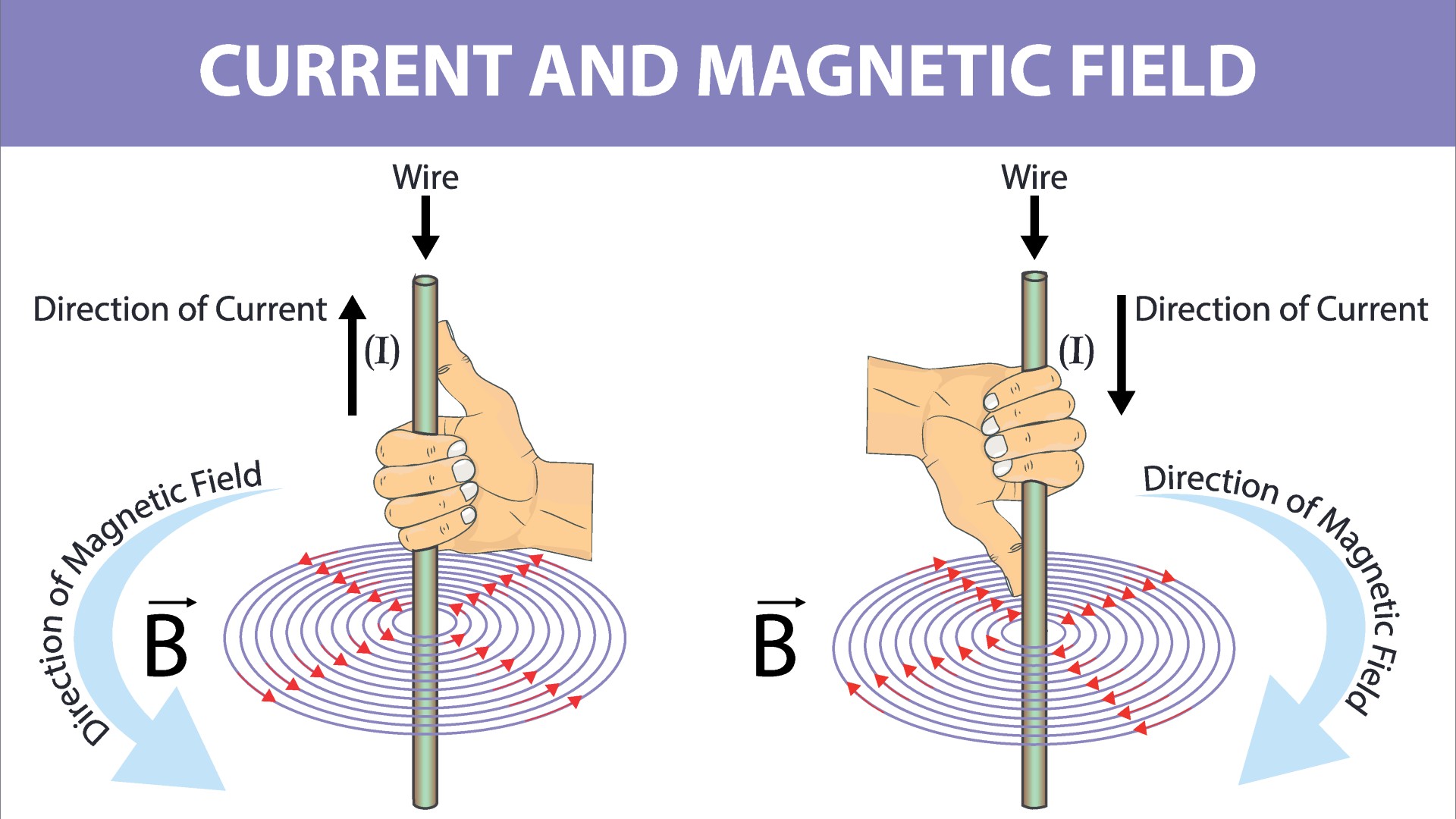What is magnetism? Facts about magnetic fields and magnetic force
Magnets, or the magnetic fields created by moving electric charges, can attract or repel other magnets, and change the motion of other charged particles.

Magnetism is a force of nature produced by moving electric charges. Sometimes these motions are microscopic and inside of a material known as magnets. Magnets, or the magnetic fields created by moving electric charges, can attract or repel other magnets, and change the motion of other charged particles.
A magnetic field exerts a force on particles known as the Lorentz force, according to Georgia State University's HyperPhysics website. The force acting on an electrically charged particle in a magnetic field depends on the magnitude of the charge, the velocity of the particle, and the strength of the magnetic field. The Lorentz force has the peculiar property that it causes particles to move in right angles to their original motion.
Some materials, such as iron, are known as permanent magnets, which means that they can sustain a permanent magnetic field. These are the most common forms of magnets encountered in everyday life. Other materials, such as iron, cobalt and nickel, can be given a temporary magnetic field by placing them inside of a larger, powerful field, but eventually those materials will lose their magnetism.
How magnetism works

Magnetic fields are generated by the motion of electric charges, according to HyperPhysics. Electrons all have a fundamental quantum mechanical property of angular momentum, known as "spin." Inside atoms, most electrons tend to form pairs in which one of them is "spin up" and the other is "spin down," or in other words their angular momenta point in opposite directions. In this case, the magnetic fields created by those spins point in opposite directions, so they cancel each other. However, some atoms contain one or more unpaired electrons, and these unpaired electrons create a tiny magnetic field. The direction of their spin determines the direction of the magnetic field, according to the Non-Destructive Testing (NDT) Resource Center. When a significant majority of unpaired electrons are aligned with their spins in the same direction, they combine to produce a magnetic field that is strong enough to be observed on a macroscopic scale.
Magnetic field sources are dipolar, meaning that they have a north and south pole. Opposite poles (N and S) attract, and like poles (N and N, or S and S) repel, according to Joseph Becker of San Jose State University. This creates a toroidal, or doughnut-shaped field, as the direction of the field propagates outward from the north pole and enters through the south pole.
Earth itself is a giant magnet. The planet gets its magnetic field from circulating electric current within the molten metallic core, according to NASA. A compass points north because the small magnetic needle in it is suspended so that it can spin freely inside its casing to align itself with Earth's magnetic field. Paradoxically, what we call the Magnetic North Pole is actually a south magnetic pole because it attracts the north magnetic poles of compass needles.
History of magnetism

If the alignment of unpaired electrons persists without the application of an external magnetic field or electric current, it produces a permanent magnet. Permanent magnets are the result of ferromagnetism. The prefix "ferro" refers to iron because permanent magnetism was first observed in a form of natural iron ore called magnetite, Fe3O4. Pieces of magnetite can be found scattered on or near the surface of the Earth, and occasionally, one will be magnetized. These naturally occurring magnets are called lodestones. While scientists don't know exactly how lodestones form, "most scientists believe that lodestone is magnetite that has been hit by lightning," according to the University of Arizona.
Get the world’s most fascinating discoveries delivered straight to your inbox.
People soon learned that they could magnetize an iron needle by stroking it with a lodestone, causing a majority of the unpaired electrons in the needle to line up in one direction. According to NASA, around A.D. 1000, the Chinese discovered that a magnet floating in a bowl of water always lined up in the north-south direction. Thereafter, the magnetic compass became a tremendous aid to navigation, particularly during the day and on nights when the stars were hidden by clouds.
Other metals besides iron can have ferromagnetic properties. These include nickel, cobalt, and some rare earth metals such as samarium or neodymium, which are used to make super-strong permanent magnets.
Other forms of magnetism
Magnetism takes many other forms, but except for ferromagnetism, they are usually too weak to be observed except by sensitive laboratory instruments or at very low temperatures. Anton Brugnams first discovered diamagnetism in 1778 while using permanent magnets in his search for materials containing iron. According to Gerald Küstler, a widely published independent German researcher and inventor, in his paper, "Diamagnetic Levitation — Historical Milestones," published in the Romanian Journal of Technical Sciences, Brugnams observed, "Only the dark and almost violet-colored bismuth displayed a particular phenomenon in the study; for when I laid a piece of it upon a round sheet of paper floating atop water, it was repelled by both poles of the magnet."
Diamagnetism is caused by the orbital motion of electrons within atoms creating tiny current loops, which produce weak magnetic fields, according to HyperPhysics. When an external magnetic field is applied to a material, these current loops tend to align in such a way as to oppose the applied field. This causes all materials to be repelled by a permanent magnet; however, the resulting force is usually too weak to be noticeable. There are, however, some notable exceptions.
Pyrolytic carbon, a substance similar to graphite, shows even stronger diamagnetism than bismuth, albeit only along one axis, and can actually be levitated above a super-strong rare earth magnet. Certain superconducting materials show even stronger diamagnetism below their critical temperature (the temperature at which they become superconducting) and so rare-earth magnets can be levitated above them. (In theory, because of their mutual repulsion, one can be levitated above the other.)
Paramagnetism occurs when a material becomes magnetic temporarily when placed in a magnetic field and reverts to its nonmagnetic state as soon as the external field is removed. When a magnetic field is applied, some of the unpaired electron spins align themselves with the field and overwhelm the opposite force produced by diamagnetism. However, the effect is only noticeable at very low temperatures, said Daniel Marsh, a professor of physics at Missouri Southern State University.
Other, more complex, forms include antiferromagnetism, in which the magnetic fields of atoms or molecules align next to each other; and spin glass behavior, which involve both ferromagnetic and antiferromagnetic interactions. Additionally, ferrimagnetism can be thought of as a combination of ferromagnetism and antiferromagnetism due to many similarities shared among them, but it still has its own uniqueness, according to the University of California, Davis.
Electricity and magnetism

When a conducting wire is moved in a magnetic field, the field induces a current in the wire. Conversely, a magnetic field is produced by an electric charge in motion, such as when a wire is carrying a current. So all the electric wires in your household produce tiny magnetic fields. This relationship between electricity and magnetism is described by Faraday's Law of Induction, which is the basis for electromagnets, electric motors and generators. A charge moving in a straight line, as through a straight wire, generates a magnetic field that spirals around the wire. When that wire is formed into a loop, the field becomes a doughnut shape, or a torus.
Direct current can also produce a constant field in one direction that can be switched on and off with the current. This field can then deflect a movable iron lever causing an audible click. This is the basis for the telegraph, invented in the 1830s by Samuel F. B. Morse, which allowed for long-distance communication over wires using a binary code based on long- and short-duration pulses, according to the Library of Congress. Skilled operators sent the pulses by quickly turning the current on and off using a spring-loaded momentary-contact switch, or key. Another operator on the receiving end would then translate the audible clicks back into letters and words.
A coil around a magnet can also be made to move in a pattern of varying frequency and amplitude to induce a current in a coil. This is the basis for a number of devices, most notably, the microphone. Sound causes a diaphragm to move in and out with the varying pressure waves. If the diaphragm is connected to a movable magnetic coil around a magnetic core, it will produce a varying current that is analogous to the incident sound waves. This electrical signal can then be amplified, recorded or transmitted as desired. Tiny super-strong rare-earth magnets are used to make miniaturized microphones for cell phones, Marsh told Live Science.
When this modulated electrical signal is applied to a coil, it produces an oscillating magnetic field, which causes the coil to move in and out over a magnetic core in that same pattern. The coil is then attached to a movable speaker cone so it can reproduce audible sound waves in the air. The first practical application for the microphone and speaker was the telephone, patented by Alexander Graham Bell in 1876, according to the Smithsonian Institution. Although this technology has been improved and refined, it is still the basis for recording and reproducing sound.
The applications of electromagnets are nearly countless. Faraday's Law of Induction forms the basis for many aspects of our modern society including not only electric motors and generators, but electromagnets of all sizes. The same principle used by a giant crane to lift junk cars at a scrap yard is also used to align microscopic magnetic particles on a computer hard disk drive to store binary data, and new applications are being developed every day.
Staff Writer Tanya Lewis contributed to this report.
Additional resources
- The National High Magnetic Field Laboratory is the largest and highest-powered magnet laboratory in the world. Researchers use the facilities for free to study materials, energy and life.
- The Internet Plasma Physics Education Experience has an interactive module about the basic concepts involved with Electricity and Magnetism.
- NASA's Goddard Space Flight Center features these lessons on the "Early History of Electricity and Magnetism" and "The Exploration of the Earth's Magnetosphere."
Bibliography
NASA, "Earth's Magnetosphere", https://www.nasa.gov/magnetosphere
"Magnetism." DISCovering Science. Gale Research, 1996. Reproduced in Discovering Collection. Farmington Hills, Mich.: Gale Group. December, 2000. http://galenet.galegroup.com/servlet/DC/
Griffiths, David J. (1998). Introduction to Electrodynamics (3rd ed.). Prentice Hall. ISBN 978-0-13-805326-0. OCLC 40251748.

 Live Science Plus
Live Science Plus





